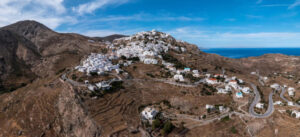Scientists are focussing on seven Greek islands under the microscope, namely Agathonisi, Amorgos, Thasos, Kassos, Serios, Sifnos, and Paxos to calculate their current needs in terms of future water demand. The aim of the research is also to identify and propose ecohydrological solutions that will contribute to rainwater harvesting to increase the water resources of the above-mentioned islands. Some of the selected islands are areas where the issue of water scarcity has been strongly observed.
Serifos and Sifnos have been declared a state of emergency by Civil Protection during this summer. This is the second phase of the pilot project that was launched on the island of Fourni on Ikaria, which was assigned by the Secretary General of the Aegean and Island Policy, M. Koutoulakis, to the Interdisciplinary Research Group of the UNESCO Chair Con-E-Ect, Democritus University of Thrace, with the participation of academics from the DUTH, NKUA, PADA, etc.
“As a General Secretariat, we are systematically investing in projects and studies that address water scarcity and emphasize rational use of planning, but based on local planning per island. Each island has different characteristics and our will is to assist municipalities in addressing water management, not only on the water supply side by implementing more and more costly projects, but also on demand management, by improving storage reservoirs, and reducing losses which in some cases reach 40%, etc. In the last 3 years, we have implemented over 300 projects in 75 islands. In 2024 we issued 25 new permits for temporary operation of desalination plants, compared to the total number of permits issued in the last 4 years. Desalination is a good solution, but we also need ecosystem solutions. This experience allows us to make a three-point design, firstly, the need for more targeted funding, secondly, better knowledge about water and study of the peculiarities of insularity and thirdly, the establishment of rules for the recovery of water costs and with social criteria for small islands,” Secretary General of the Aegean and Island Policy of the Ministry of Shipping and Island Policy, Manolis Koutoulakis, told APPE-MPA.
As noted by Dimitris Emmanouloudis, Professor of Mountain Water Management and Director of the UNESCO Con-E-Ect Chair at the Democritus University of Thrace, “it was found that with the help of technical interventions and projects, it is possible to cover not only the current needs but also the future water demand until 2030, during the summer months (June, July and August), at a rate of 100%. In this way, it is possible, on the one hand, not to use the underground water resources of the island, so that they can be used in their entirety by the inhabitants during the months when there is no tourism, for all kinds of uses (domestic, agriculture, livestock farming, etc.), and on the other hand, the water offered to visitors – tourists, is rainwater and not desalinated, with all that this means for the improvement of the services provided to them.
According to Mr. Emmanouloudis, due to the encouraging results of the previous research, a research project is to be launched immediately after the same institution has awarded the same interdisciplinary research team, which will constitute the extended second phase of the previous one. This project will attempt to accurately calculate current needs and future water demand in these seven islands of our country, using modern computational methods and indicators. These islands have been selected based on climatic, geomorphological, social, geographical and tourism criteria.
“Small-scale technical projects and ecosystem-friendly solutions will then be proposed in order to achieve maximum rainwater harvesting during the winter months. The aim is to strengthen water resources and limit the use of desalinated water as far as possible, depending on the situation of each island. It is understood that the dimensions, number, and exact nature of these projects will vary from island to island, depending on the climatic and geomorphological conditions and the size of the water deficit to be covered. The final future goal (which does not concern the second phase mentioned) is the creation of a comprehensive picture of the needs and demand for water in all the small and medium-sized islands of the country and a comprehensive plan to assist in finding solutions for saving rainwater, in order to enhance their water resources as much as possible, but also to limit desalination,” Mr. Emmanouloudis stresses to APE-MPA.
With the problem of water scarcity having reached great proportions this year due to climatic conditions, several areas of the country during the summer months in particular, were put in a state of emergency by the Civil Protection. Mr. Emmanouloudis explaining exactly the term water scarcity stresses that this is the phenomenon in which this valuable natural resource, water, is offered in smaller or much smaller quantities than those that man, the flora and fauna of a specific or wider area needs to meet their respective needs and adds that usually the water scarcity of an area is closely linked to the lack of rainfall for a long period in that area (drought). But there is also the case – quite frequent in recent decades – that water scarcity occurs in an area even if there is sufficient rainfall. “This happens because the demand for water in this area exceeds the supply of water from surface and underground aquifers,” he notes. Observing the conditions prevailing this year, Mr Emmanouloudis points out that the phenomenon of water scarcity falls under the first of the aforementioned cases as it was found that rainfall during the winter period in most areas of the country was below average, while snowfall was almost non-existent. These conditions are compounded by the very high temperatures observed throughout the country since last March and April. “All the above-mentioned events have created an explosive “cocktail”, the consequences of which we are experiencing at this time”, Mr. Emmanouloudis points out and adds that the negative effects are too many and extremely adverse.
“Indicatively, we mention the very significant increase in the risk of forest fires because the flammability of vegetation increases, the risk of destruction of crops of all kinds with all that this implies for the food supply chain, humans and animals, the risk for the normal development of flora and the survival of fauna (diseases, mass deaths). As regards the negative effects on humans, these relate to their health, hygiene, quality of life and economic well-being, because water scarcity also negatively affects several services or products, such as tourism, industry, construction, etc.. It is easy to see that the phenomenon of water scarcity takes on even more nightmarish dimensions as long as a region has an increased seasonal concentration of population, which is the case in most island regions of our country, due to tourism.
“Suffocating hydrological conditions in island regions during the summer season”
With our country receiving a large number of tourists, which, as Mr. Emmanouloudis points out, in recent years exceeds 30,000,000, of which the majority during the summer season, these visitors are concentrated in a large percentage in the capital and island regions, creating in the latter, suffocating hydrological conditions, taking into account the adverse climatic conditions mentioned above. For this reason, Mr. Emmanouloudis expresses his fears and concern that “no matter how many new water storage projects are proposed (especially on the country’s popular tourist islands) and no matter how many are built, as well as no matter how many desalination plants are created, from a certain threshold of visitors onwards, the situation will be unmanageable”. “In this case, the State, in consultation with the local authorities of these areas and the residents, should jointly define a new tourism policy, which will lead to sustainable situations for people, flora, fauna and fish fauna of these areas”, Mr. Emmanouloudis stresses.
“Obvious impact on lakes in most of the country”
However, in addition to the water scarcity issues observed in several areas of the country, the lowering of lake levels has also been noted. According to Emmanouloudis, this is generally the result of several factors (climatic, geomorphological, tectonic, technical, etc.). During this year, as he explains, the observed descent of the level in our country’s lakes is due on the one hand to the aforementioned lack of rainfall and snowfall – because many of them are supplied with water from mountainous watersheds,which are usually covered with snow – and on the other hand to the very high temperatures and intense sunshine, prevailing since last March, which result in the intense evaporation of the upper layers of water in the lakes.
“The phenomenon is visually more pronounced in shallow lakes, such as Doirani, whose deepest point is 4 m and where a 2 m drop in the lake level appears to have halved the lake’s depth. It should be noted that artificial lakes – reservoirs – such as Mornos, Lake Plastira, etc. are not excluded from this phenomenon. Unfortunately, if we exclude artificial or natural lakes in the north-western parts of the country, in the rest of the country, even in Northern Greece (see Doirani, Lake Lagada in Thessaloniki, etc.), the effects are very obvious to obvious”, he stresses.
“It is imperative to take a series of measures to address the urgent situation”
According to Mr. Emmanouloudis, to address this urgent situation – crisis, it is imperative to take a series of measures, as is done in all cases of crisis occurrence (health, economic, environmental, etc.).
These, as he explains, fall into three categories: immediate, short-term and medium-term.
In particular, Mr. Emmanouloudis proposes the following measures:
The main recommendations are as follows.
In the immediate term:
Adopting an individual culture of water conservation in our daily lives (food preparation, personal hygiene, cleaning). This measure becomes even more imperative for catering businesses and hotels.
Adoption of irrigation methods in agriculture, which are not water-intensive, if necessary changing the type of crops (do not forget that agriculture consumes 70% of the available water resources worldwide! ).
Avoidance of any kind (at least for the summer period) of water use for recreational, aesthetic purposes, etc. (swimming pools, fountains, garden irrigation).
In the short term:
Limitation of losses of water transport and distribution networks, from storage tanks or water intake points to domestic – commercial consumption, given that network losses in our country, even in the capital region range from 45 – 55% (with an internationally accepted limit of 20%), which in simple terms means that of the amount of water supplied, half of it reaches the point of consumption!
The reduction of losses will result from the repair of leaks and faults on the one hand, and from the improvement and modernization of existing networks on the other.
In the medium term:
Accurate calculation of current needs and future demand, especially in areas with increased tourist traffic. This calculation can be done with the help of modern calculation methods, based on newly introduced indicators such as the Water Footprint. The Water Footprint is essentially the amount of water used by a person, business or industry daily. From this calculation, it is possible to accurately derive the annual water deficit for a given area, for different climate scenarios, in the present and shortly, which makes it essential for the selection of appropriate water storage projects in a region and their corresponding design, in terms of location and size. These projects should aim to cover this deficit as far as possible, even in adverse scenarios.
The construction of small-scale engineering works (rainwater barriers, spillway dams, etc.) using the above-mentioned calculation methods. These projects can be combined with ecosystem-based adaptation techniques. The construction of these projects is particularly suitable for island regions where the necessary attention must be paid to the aesthetics of the interventions, and they are highly effective for rainwater harvesting, even from short and intense rainfall events, and can be combined with a range of nature-based solutions. The collected rainwater will be stored in underground tanks to avoid evaporation losses.
.
Ask me anything
Explore related questions





